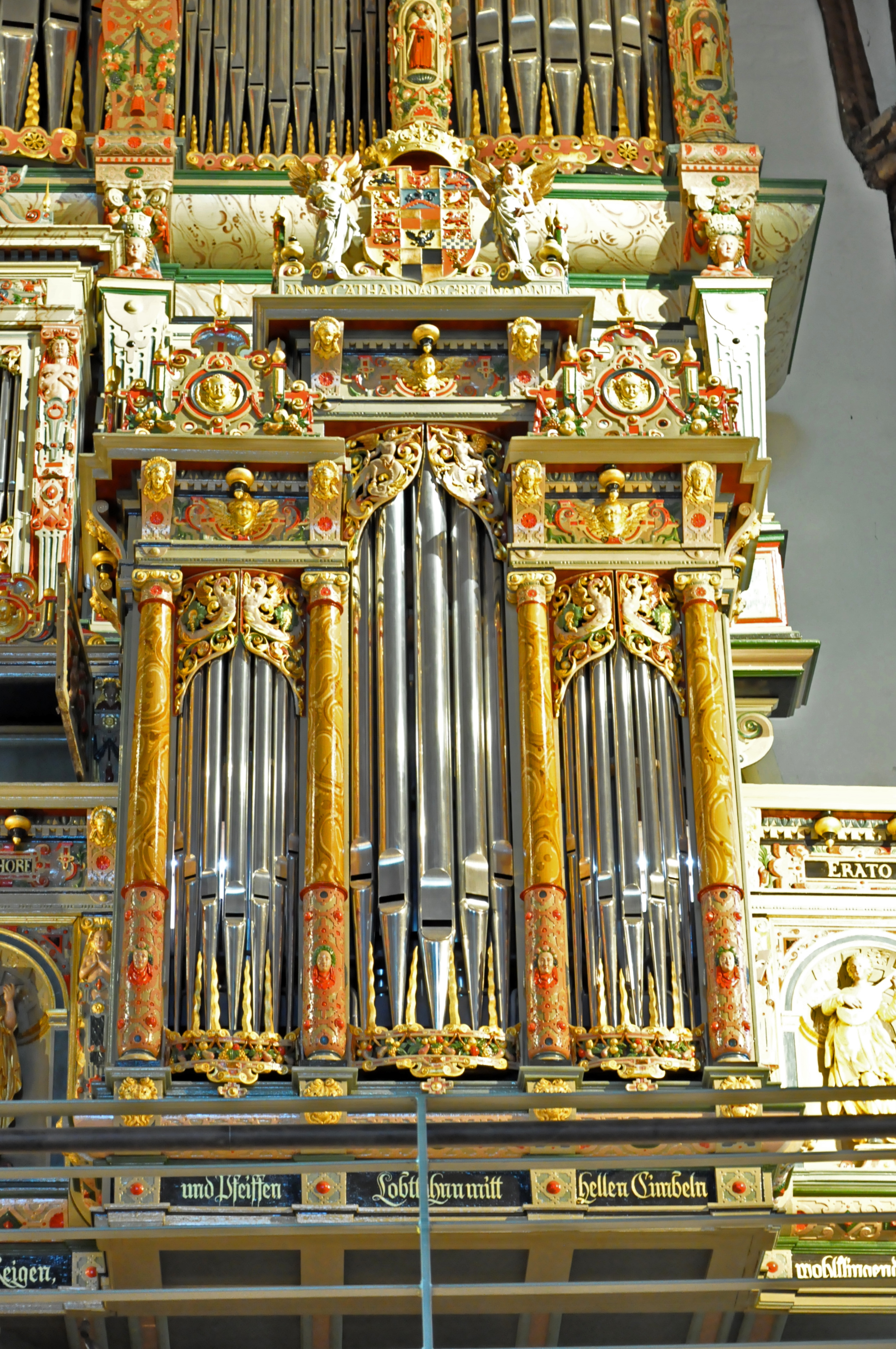Flensburg, St. Nikolai (Schnitger-organ)
| Builder | G. Woehl |
|---|---|
| Year | ca. 2009 |
| Period/Style | Baroque |
| Stops | 42 |
| Keyboards | 3+P |
| Keyaction | tracker/mechanical |
| Tuning | 1/4 Comma Meantone |
The organ at Sankt Nikolai, a significant Renaissance church in northern Germany, houses one of the region's most prominent organs. The original instrument, a marvel of the Renaissance era, was commissioned by Danish King Christian IV and built by Danish royal organ builder Nicolaus Maass between 1604 and 1609. Between 1707 to 1709, the organ was remodeled and expanded into a Baroque work by Arp Schnitger. The 15-meter tall and 7-meter wide organ case, an exquisite masterpiece by Flensburg sculptor Heinrich Ringeringk, remains one of the most significant in Northern Europe.
However, due to unsystematic renovations since 1920, the instrument was damaged. From 1997 to 2009, internationally renowned organ builder, Gerald Woehl from Marburg, undertook an ambitious project to restore the organ. For the first time ever, two stylistically different instruments were created behind the restored, originally coloured case.
The historical casing harbours a reconstruction of the Schnitger organ (1709) with its specific features, like the old mean-tone tuning and the lively 'breathing' wind supply from three traditional wedge bellows enabling authentic reproduction of North German Baroque music.
Behind it is a symphonic organ signifying the characteristics of grand romantic organs, with modern equal temperament tuning. This secondary organ, powered by eight reserve bellows, allows for a broad range of sound dynamics, from the softest pianissimo to a grandiose symphonic tutti. It has its own detached console (four manuals/pedal) situated on the choir balcony underneath the organ loft.
Since its completion, the Sankt Nikolai organ isn't just the largest organ in Schleswig again, but also a unique instrument in its genre: a renowned national cultural monument from the Renaissance era to look at and an impressive North German Baroque organ following Schnitger's example and a symphonic-romantic instrument to listen to. This organ embodies the fluctuating organ history of Sankt Nikolai over the last 400 years with its exceptional alliance of historical legacy and modern redesign.
However, due to unsystematic renovations since 1920, the instrument was damaged. From 1997 to 2009, internationally renowned organ builder, Gerald Woehl from Marburg, undertook an ambitious project to restore the organ. For the first time ever, two stylistically different instruments were created behind the restored, originally coloured case.
The historical casing harbours a reconstruction of the Schnitger organ (1709) with its specific features, like the old mean-tone tuning and the lively 'breathing' wind supply from three traditional wedge bellows enabling authentic reproduction of North German Baroque music.
Behind it is a symphonic organ signifying the characteristics of grand romantic organs, with modern equal temperament tuning. This secondary organ, powered by eight reserve bellows, allows for a broad range of sound dynamics, from the softest pianissimo to a grandiose symphonic tutti. It has its own detached console (four manuals/pedal) situated on the choir balcony underneath the organ loft.
Since its completion, the Sankt Nikolai organ isn't just the largest organ in Schleswig again, but also a unique instrument in its genre: a renowned national cultural monument from the Renaissance era to look at and an impressive North German Baroque organ following Schnitger's example and a symphonic-romantic instrument to listen to. This organ embodies the fluctuating organ history of Sankt Nikolai over the last 400 years with its exceptional alliance of historical legacy and modern redesign.
| Rückpositiv (I) | Hauptwerk (II) | Brustwerk (III) | Pedal |
|---|---|---|---|
| Principal 8' | Principal 16' | Fluit dues 8' | Untersatz 16' |
| Quintadena 8' | Bordun 16' | Blockflöte 8' | Octav 8' |
| Gedackt 8' | Octav 8' | Octav 4' | Octav 4' |
| Octav 4' | Rohrflöte 8' | Octav 2' | Rauschpfeife 2f. |
| Flöte 4' | Octav 4' | Sieflit 1 1⁄2′ | Mixtur 5-6f. |
| Octav 2' | Nassat 3' | Waldflöte 2' | Nachthorn 2' |
| Sexquialtera 2f. | Super Octav 2' | Rauschpfeife 2f. | Posaunen 16' |
| Mixtur 5-6f. | Mixtur 5-7f. | Scharf 4f. | Trommet 8' |
| Dulcian 16' | Cimbel 3f. | Dulcian 8' | Schalmey 4' |
| Baarpfeife 8' | Trommet 16' | Crumphorn 8' | Cornet 2' |
| Trommet 8' | |||
| Vox humana 8' |
No Video/Audio samples available.
https://organindex.de/index.php?title=Flensburg,_St._Nikolai_(klassische_Orgel)
 Pipe Organ Map
Pipe Organ Map
